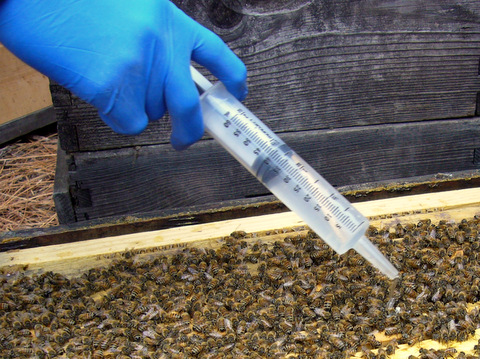Image Credit: Randy Oliver, ScientificBeekeeping.com
The oxalic acid dribble method is a simple, low-cost way to treat honey bee colonies for varroa mites—especially during cooler months or when brood levels are low. It’s widely used across Europe and the U.S., and when applied correctly, it’s a safe and effective tool in your varroa management plan.
This article explains how the dribble method works, when to use it, and how to follow the application process recommended by beekeeping researcher Randy Oliver at ScientificBeekeeping.com.
What Is the Dribble Method?
The dribble method involves mixing oxalic acid into a sugar syrup solution and slowly applying it directly onto the bees clustered between frames. The mixture coats the bees and allows the acid to be absorbed through contact, killing phoretic (hitchhiking) mites on adult bees.
This method does not penetrate capped brood, so timing is important. The best results are achieved when colonies are broodless or have minimal brood.
When Should You Use It?
The dribble method is typically used in late fall, early winter, or any time your colony is largely broodless. It’s also an excellent option for new packages before brood rearing starts, or after a brood break in summer.
Unlike vaporization, dribbling does not require power tools or a respirator, but it is still a chemical treatment and should be handled carefully.
Randy Oliver’s Recommended Dribble Formula
Randy Oliver’s research shows that a 1:1 sugar syrup mixed with 35 grams of oxalic acid dihydrate per liter of syrup provides effective mite control with minimal colony disruption.
Here’s the basic recipe for the solution:
- 1 liter of 1:1 sugar syrup (500g sugar + 500mL water)
- 35 grams of oxalic acid dihydrate (not anhydrous)
Stir the oxalic acid into the syrup thoroughly until completely dissolved. Store in a labeled container, and only mix what you’ll use that day.
How to Apply It
- Open the hive and gently expose the tops of the brood frames
- Use a dosing syringe or dribble bottle to apply the solution
- Apply 5mL of the solution per seam of bees (the space between each frame with a visible cluster)
- Do not exceed a total of 50mL per colony
Dribble the solution slowly across the top bars where the bees are most concentrated. Avoid flooding the bees or dribbling directly into open cells.
Important Notes
- Only treat once per brood cycle. Do not reapply repeatedly as it can damage the bees’ gut lining
- Do not use this method in warm weather or during nectar flow
- Best applied when daytime temps are above 40°F (4°C) but still cool enough to keep the cluster tight
- Dispose of leftover solution safely—it is an acid, and not meant for long-term storage
Effectiveness
In broodless colonies, Randy’s field data shows the dribble method can eliminate 90% or more of phoretic mites with a single application. It’s one of the best low-tech options available for small-scale and hobbyist beekeepers.
Final Thoughts
The dribble method is a powerful, affordable option for varroa control—especially when brood is minimal. When combined with mite monitoring, seasonal awareness, and a broader Integrated Pest Management (IPM) approach, it can help you keep mite loads in check without over-relying on synthetic treatments.
To dive deeper into the science and field-tested details behind this method, visit ScientificBeekeeping.com. Randy Oliver has published extensive research and testing data, making his site a trusted resource for both beginner and advanced beekeepers.
Want More Beekeeping Info?
